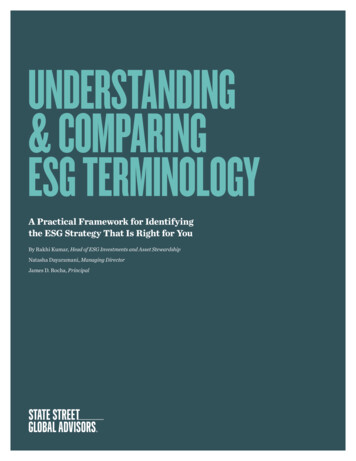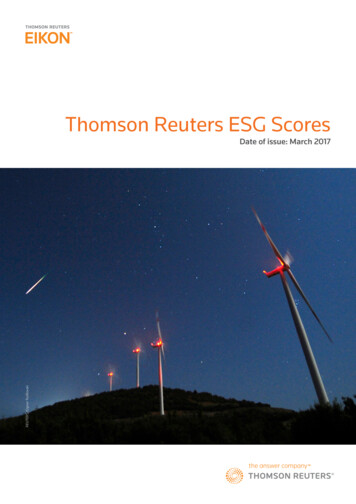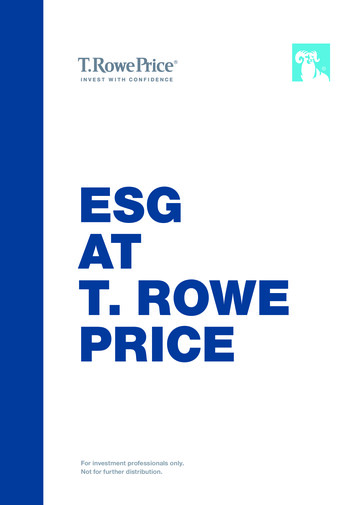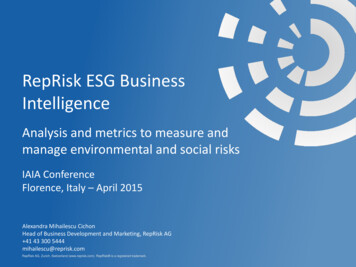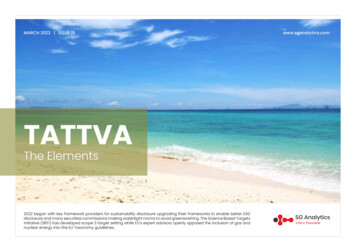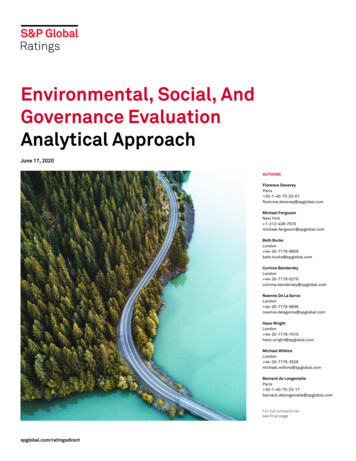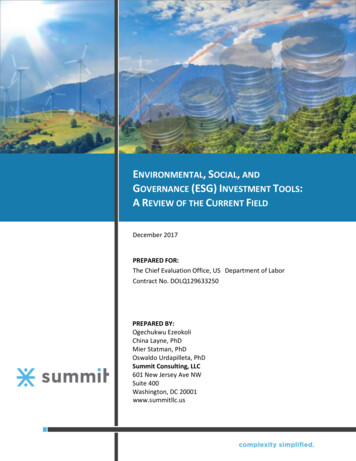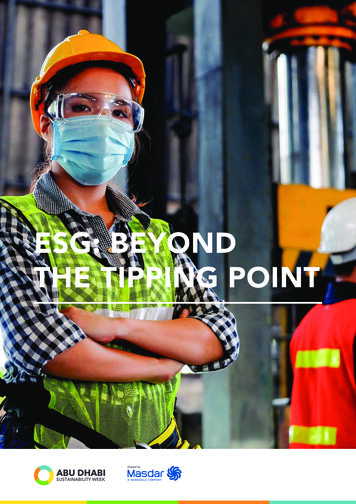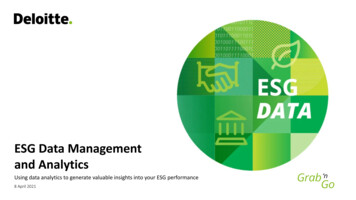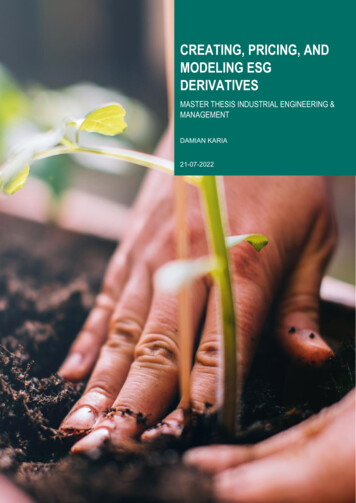
Transcription
CREATING, PRICING, ANDMODELING ESGDERIVATIVESMASTER THESIS INDUSTRIAL ENGINEERING &MANAGEMENTDAMIAN KARIA21-07-20221 Page
Creating, Pricing, and Modeling ESG DerivativesAuthorDamian KariaMSc Financial Engineering & ManagementFaculty of Behavioural Sciences and Social Sciences (BMS)ABN AMROGustav Mahlerlaan 101082 PP AmsterdamThe NetherlandsUniversity of TwenteDrienerlolaan 57522 NB EnschedeThe NetherlandsSupervisorAnton Koers (Global Markets)SupervisorsProf. Dr. Ir. Albertus Bruggink (BMS)Dr. Ir. Wouter van Heeswijk (BMS)COPYRIGHT University of Twente, The NetherlandsAll rights reserved. No part of this publication may be reproduced, stored in a retrieval system, or transmitted in any form or by anymeans, be it electronic, mechanical, by photocopies, or recordingsIn any other way, without the prior written permission of the University of Twente.2 Page
EXECUTIVE SUMMARYRegulations and pressure from society have led to new climate policies for businesses. Last years, this pressure expandedits range to social and governance aspects within companies. ESG (Environment, Social, and Governance) is therefore atrending topic for businesses but especially for banks, as they play a significant role because they are at the center of theeconomy. Banks have constructed financial ESG-linked products that stimulate companies to improve ESG-related KPIswithin their organization. However, the range of financial ESG-linked products that are currently offered by banks is stilllimited, therefore, we researched how we can create new ESG-related products, how we can price them, and how we canmodel them. This research is commissioned by ABN AMRO but the research is general and not focused on the Dutch bank.The answers to the research questions were found by a combination of literature research, conversations with differentdepartments of ABN AMRO, and modeling.Before the creation of new ESG-linked products, we researched the reasons were to creating and offering ESG-linkedproducts. We found that there are four main reasons: customer demand, regulations, profit potential, and competition.Customer demand for sustainability-linked products increased rapidly in 2021, which shows the opportunities for banks andthe interest in ESG products. It also shows that competition is already offering ESG-linked products and that this competitionis profiting from this flourishing market. Several regulations like the Sustainable Finance Disclosure (SFDR), the CorporateSustainability Reporting Directive (CSRD), and more are forcing banks to report on ESG aspects not only from the bank itselfbut also from their portfolio. The regulations are a trigger for banks to think about their ESG strategies and policies. Next tothose reasons, we have profit potential. Banks that are offering ESG-related products focus mostly on green businesses, butthere is a market of transition businesses that is relatively untapped. Within this transition business market, banks shouldfocus on the companies that face the biggest pressure to adapt and at the same time, are the most competent to transform.ESG-linked products always have a KPI component. There are different guidelines for setting up KPIs for ESG-linkedproducts, however, there are no general restrictions that hold for every company. Therefore, we wanted to create a KPIframework that can be used by every business. We think that focusing on material ESG KPIs would contribute to a higherfinancial performance of the organization. We found that SASB’s Materiality Map which tries to generalize material ESGissues is a good starting framework. We expanded the Materiality Map with a “Corporate Governance” column and theircorresponding material issues, as we found that SASB’s Materiality Map did not incorporate the “G” of ESG accurately. WithSASB’s Materiality Finder, we can find the material ESG issues in a certain sector for every company. The bank needs toinspect the “Corporate Governance” material issues at the company themselves. Together with the counterparty, they decideon which material ESG issues are the most important. Once this is set, the bank can look up the material ESG issues inWorld Economic Forum’s 2020 whitepaper about ESG metrics. Here, the material ESG issues can be coupled with thematerial ESG KPIs. Again, the bank and the counterparty decide together which KPIs are chosen to be tracked in thefinancial product. The tracking can be done either by the bank themselves by analyzing the ESG KPIs out of the company’sannual report or by an independent third party. The latter reduces the chances of issues like corruption and bribery.After analyzing the current ESG-linked products being offered, we found that these products are all constructed in the sameway. There is a base financial product, e.g. an interest rate swap or bond with on top of it a bonus/malus KPI structure, whichis offered to the counterparty. If the counterparty achieves a predetermined KPI goal, it will get a discount of a particularamount of basis points on its base product till maturity otherwise. If the counterparty does not reach this goal, thecounterparty pays either a certain amount of basis points penalty till maturity or nothing happens. Most of the times, the KPIsare based on an educated guess and therefore KPI targets are often reached. This way of offering ESG-linked products isnot viable for the bank in the long run. We tried to model the KPI structure as an option, using the binomial tree model andthe binary model as the foundation. We created two KPI option models, which allow banks to price KPI options on top of thebase financial product they offer. Our KPI option models are based on the company’s historical volatility of a KPI, or that of acompany of a similar size and sector. This way of pricing the KPI gives banks a viable model.3 Page
TABLE OF CONTENTExecutive Summary . 31.2.Introduction . 61.1ABN AMRO . 61.2Research Motivation . 61.3Problem Statement . 61.4Research Goal & scope . 71.5Research questions . 71.6Approach . 8Environment, Social & Governance. 92.13.ESG . 92.1.1Environment . 92.1.2Social . 92.1.3Governance . 10Literature Review . 113.1The goal of offering ESG products . 113.1.1Reasons to offer ESG products . 113.1.2How do clients stimulate ESG among third parties? . 133.2What are relevant products to offer? . 133.3How to construct ESG-linked derivatives? . 143.3.1Classification of ESG KPIs . 143.3.2Which ESG KPIs are important in general? . 163.3.3How do we measure those KPIs? . 203.3.4How do we stimulate the clients to achieve the KPI goals? . 203.4How do we price the ESG-linked derivative? . 203.4.13.54.5.What does our ESG-linked derivative look like? . 20What are the possible risks and how do we incorporate these inTO the price? . 213.5.1Which risks are related to offering our ESG-linked product? . 213.5.2How can we mitigate those risks? . 23Models . 254.1Binomial KPI tree . 254.2Binary KPI options . 27Analyses & Results . 295.1Binomial KPI tree . 295.1.1Binomial KPI Call . 295.1.2Binomial KPI Put . 305.2Binary KPI options . 305.2.1Binary KPI Call . 305.2.2Binary KPI Put . 314 Page
5.35.3.1Delta . 325.3.2Gamma . 335.3.3Vega . 355.3.4Theta . 375.3.5Rho . 385.46.7.ESG Greeks . 31What does the total financial product look like? . 40Conclusions and recommendations . 416.1Conclusions . 416.2Recommendations . 43Discussion . 457.1Generalization. 457.2Scientific relevance . 457.3Further research . 458.References . 479.Appendix . 509.1Jupyter Notebook scripts . 509.1.1Binomial KPI options. 509.1.2Binary KPI Options . 559.1.3ESG Greeks . 595 Page
1. INTRODUCTION1.1ABN AMROABN AMRO is a Dutch bank whose head office is located in Amsterdam. The history of ABN AMRO reaches back to 1720.The bank originated from multiple mergers throughout history. The most important ones happened in 1991 and 2010. In1991 ABN merged with AMRO (a merger between the Amsterdamsche Bank and Rotterdamsche Bank) which created thelargest bank in the Netherlands at that moment in time. In 2010 ABN AMRO Bank merged with Fortis Bank Nederland andbecame ABN AMRO Bank N.V. In 2021, the bank had nearly 20.000 employees, which serves more than 5 million clientsaround the world with products and services like loans, mortgages, payments, financial advice and asset management (ABNAMRO Bank N.V., 2022). The bank serves over 365.000 commercial clients of which most are small and medium-sizedenterprises (SMEs). ABN AMRO amounted 50.6 billion euros to their corporate and institutional clients in loans andadvances.1.2RESEARCH MOTIVATIONABN AMRO offers an extensive bundle of financial products for their corporate and institutional clients. The products andservices offered to their clients worldwide, produce a turnover of more than 250 million (ABN AMRO, 2020a). However,after ABN AMRO’s strategy review in 2020, they decided to focus more on Northwest Europe and limit their Corporate andInstitutional Banking (CIB) to their core sectors. To increase their market share, in Northwest Europe, they set new targetsand ambitions up till 2024. The strategic pillars are customer experience, sustainability, and future-proof banking. In thisresearch, we will especially focus on the second pillar, sustainability. When banks are talking about sustainability, they do notsolely focus on the environmental part anymore. Nowadays, sustainability is also connected to social and governanceaspects. Are companies sustainably managing their social capital? Is the management capable to mitigate possibilities forcorruption in a sustainable manner? These questions are tied to the term ESG, which stands for environment, social, andgovernance. The demand from corporate and institutional clients for ESG-linked products is rapidly increasing. ABN AMROoffers already a variety of ESG-linked products reaching from sustainability-linked loans (SLLs) to sustainability-linkedswaps. In 2020 ABN AMRO was an underwriter of a sustainability-linked loan to Royal Avebe, a Dutch starch manufacturer.The parties involved agreed on certain KPIs that would stimulate sustainability factors within Avebe’s company. If Avebereached the sustainability targets, they get a discount on their interest rate (ABN AMRO, 2020b).Because of the rising volume of such investment, banks are in a position where they need to decide whether they want to bea leader in the sector, follow the competitors, or just want to comply with regulations. ABN AMRO stated in their strategy that“Sustainability is a differentiator. We want to be a first choice partner on it for our clients and lead by example” (ABN AMRO,2021a). In their 2021 annual report, they listed that for the short to medium term (0-5 years) they want to increase insight intothe needs of their clients to be able to help them in their sustainability shift and to discover new financing opportunities toenable this transition (ABN AMRO Bank N.V., 2022). Therefore, ABN AMRO is seeking possibilities to expand the packageof financial products that are ESG related.1.3PROBLEM STATEMENTABN AMRO wants to be the first choice partner on sustainability-linked products. Currently, the bank is already offering ESGproducts for retail investors. However, these only contain ETFs, bonds, and investment funds. ABN AMRO also wants tooffer products that can meet the specific wishes of a company or investor. We already know that ABN AMRO offers differentESG-linked products, which can be structured with company-specific KPIs. Nevertheless, the bank wants to researchwhether there are more options to expand the current financial product offering that is ESG related and not limited toenvironmental issues. At the moment, knowledge of ESG products, especially on ESG-linked derivatives and ESG data arescarce, these are an obstacle to creating ESG products. In Figure 1 we depicted the problem in a simplified problem cluster.6 Page
Figure 1: Simplified problem cluster for banks1.4RESEARCH GOAL & SCOPEThe goal of this research is to gain knowledge on ESG products that are currently available in the market, construct an ESGKPI framework, create and price an ESG-linked derivative using the framework, and develop a tool that allows the bank todesign a tailor-made derivative which is linked to ESG. The aim is that this tool can be used to create products that aretailored and made for specific corporate and institutional clients. We will create this tool using Python. We limit the scope ofthis research to corporate and institutional clients and focus on one specific ESG-linked derivative because of the timeconstraint of 20 weeks. However, this tool might lay the foundation for the creation of other derivatives. We chose to focus onESG-linked derivatives because other ESG-linked products like sustainability-linked bonds and sustainability-linked loans arealready getting familiar in the financial market.1.5RESEARCH QUESTIONSThe core problem is that there is a knowledge gap between what is wanted and the current situation of the bank (Heerkens &van Winden, 2012). The ideal situation is that ABN AMRO knows how to create, price, and model ESG-linked products. Themain research question is therefore stated as follows:How could ABN AMRO create, price, and model financial products that promote ESG among its corporate andinstitutional clients, and third parties?To answer this research question, we need to answer some other questions first. We, therefore, created a list of subresearch questions that need to be answered first, to answer the main one. To discover why ABN AMRO wants to create,price, and model ESG-related products, we need to find out the goal of offering ESG-linked products. We set up the followingquestions:1.What is the goal of creating ESG-related products?a. What are the reasons to offer ESG products?i. How do clients promote/stimulate ESG among third parties?b. What are relevant products to offer?7 Page
Once we have identified the reasons behind offering ESG-connected products, we need to know how to build theseproducts. What do we need to create the products? How do we value them? How do we take into account certain risks?These are the questions that are going to be answered with the help of the following sub-questions:2.How do we construct ESG-linked products?a. Which ESG KPIs are important? How do we classify them?i. How do we measure those KPIs?ii. How do we stimulate the clients to reach the KPI goals?b.How do we price these products?i. What does our ESG-linked need to look like?ii. How sensitive are certain values in the pricing model?c.What are the risks and how do we incorporate these into the price?i. Which risks are related to offering our ESG-linked product?ii. How can we mitigate ESG risks in general?By gathering the knowledge that is found in the answers to the questions that are mentioned above, we will ultimately havecongregated enough information to start building a model for our ESG-linked product. Afterward, we will start modeling theproduct using Python to price it. This will also help us visualize and test our model and would act as a foundation for otherfuture ESG-linked derivative pricing models.1.6APPROACHFor every question, we will perform literature research. However, for questions 2.a. and 2.c. we will also have conversationswith the appropriate departments within ABN AMRO to see which KPIs are currently used and if there are alreadyframeworks in use for sustainability-linked products. Furthermore, we will discuss which risks are taken into account at thismoment and if these are incorporated into the price of sustainable financial products.We will first explain ESG and thereafter perform literature research for every question, then we will create a KPI frameworkand construct a pricing model for our ESG-linked product and ultimately we will program this in Python.8 Page
2. ENVIRONMENT, SOCIAL & GOVERNANCE2.1ESGEnvironment, social, and governance, better known as ESG, is becoming increasingly important. In 2015 two majoragreements were adopted. The first one was the “2030 Agenda for Sustainable Development” which was adopted by allUnited Nations member states (UN, 2015). This agenda contained the 17 sustainable development goals (SDGs) whichreach from reduced inequality to climate action. The second agreement was the Paris Agreement. The goal of the ParisAgreement was to limit global average temperature warming to a maximum of 2 C above pre-industrial levels and to pursueefforts to limit the increase to 1.5 C (UNFCCC, 2015). These agreements, together with the European Green Deal, form thebasis for the European ESG targets. Lannoo & Thomadakis (2020) call the European Green Deal the cornerstone of theEU’s response to the Covid-19 pandemic because of the large amounts required for a sustainable and green recovery. Theirresearch showed that ESG products were resilient during the market decline caused by the pandemic and will play a vitalrole in fastening the transition to a sustainable economy. We believe that also the war between Russia and Ukraine willaccelerate the transition to a sustainable economy as fewer Western countries want to be dependent on Russian gas and oil.Accordingly to the agreements, companies in all sectors have adjusted their goals and missions to contribute to thesecommon goals. Banks are at the centre of the economic transformation. Also, ABN AMRO implemented ESG goals in itsthree strategic pillars. ABN AMRO does not only try to include ESG in their own company but also tries to stimulate othercompanies. A few examples are:- To make at least 46 billion in ESG impact investments by 2024- To make at least 25% of the corporate loans sustainable by 2024- To be in the top 5% of the most sustainable banks worldwide (ABN AMRO, 2021b)ABN AMRO partnered up with Sustainalytics. Sustainalytics investigates and assesses ESG risk scores of companies. Thisscore is an aggregated score of the amount a company is exposed to different material ESG issues and how well themanagement of a company is handling relevant ESG issues (Sustainalytics, 2022). These scores can be used by investorsto see how well a company is scoring on ESG factors.In the next part, we will explain each letter of ESG and show some examples of focus areas of each aspect.2.1.1EnvironmentEnvironment is the most known factor in ESG. When people are talking about ESG, most of the time the emphasis lies onsustainability. When looking at a company’s environmental part, it may include the company’s energy use, waste,greenhouse gas (GHG) emissions, or circularity. Banks stimulate the “E” in various ways. The first way is by making theirproducts and services more sustainable, e.g. offering financial products that have a positive impact on the environment.Sustainability-linked loans (SLLs) and sustainable/green bonds have rapidly grown over the years. In 2021 sustainablebonds reached one trillion dollars, which is 20 times as much as in 2015 (Toole, 2022). Investors seem to become moreinterested in the environmental impact they could have (EY, 2021a). The second way is by investing in companies that havea positive effect on the environment or in enterprises that want to transition to a more sustainable way of operating. In thisway, the bank does not only have a direct impact with its products and services but also with its investment portfolio.2.1.2SocialSocial is the part where we are talking about how companies treat stakeholders, e.g. how are the relationships withemployees/suppliers/customers/shareholders managed? What are the gender and diversity ratios within the firm? These arequestions that are asked when the social aspect of a business is measured. When is looked at investment decisions of fundmanagers and institutional investors, according to (EY, 2021a) the social aspects, Human rights practices, Diversity, Equity,and Inclusion (DEI), are the least chosen top characteristics of these investors (see Figure 2).9 Page
Figure 2: Investment focus of fund and institutional investors. Source: EY, 2021.2.1.3GovernanceThe latest aspect of ESG is governance. This deals with the company’s leadership. Here, the composition of the board,executive pay, audit teams, and shareholder rights are examined. Robust governance has always been at the center ofattention for investors. Investors believe that strong shareholder rights lead to higher returns due to the increased influenceof the shareholders at firms (EY, 2021a).10 P a g e
3. LITERATURE REVIEW3.1THE GOAL OF OFFERING ESG PRODUCTS3.1.1Reasons to offer ESG productsWhen we are talking about reasons for banks to offer ESG products, we can divide the reasons into four categories, namely:customer demand, regulations, profit potential, and competition. In this section, we will describe the reasons to offer ESGproducts as a bank for each category.Customer demandWhen we are looking at SMEs, nearly 70% of the companies that were surveyed by Zeb expect their bank to offer ESGfinancing products (Rupp et al., 2021). This means that there is a great market to offer ESG financing products. We see thatESG financing products like sustainability-linked loans surged last years. These loans saw a 300% rise in 2021 to 717billion (Toole, 2022).To find out which specific wishes there are from corporate and institutional clients, the bank needs to address these clients tofind out what ESG financing products the clients are looking for. Obviously, this can differ drastically per bank, as each bankfocuses on various clients that work in different sectors. We do not know whether ESG-linked derivatives will see the sameincrease in demand as ESG financing products but we know from a study by Lannoo & Thomadakis (2020) that derivativescan play a significant role in the context of the European Green Deal and the transition towards a low-carbon economy.Therefore, banks should be prepared for a market that could rapidly expand.Investors are also asking for ESG investing products to gain exposure to ESG. Therefore, banks need to think about howthey would facilitate this. ABN AMRO is already offering ESG funds which are a combination of portfolios of ESG equities orESG bonds. Most of these portfolios exclude companies that are involved in the tobacco, alcohol, or weapon industry.Furthermore, these portfolios are selecting companies that score high on different ESG KPIs such as low CO2 emission or ahigh percentage of women in the top management.RegulationsIt can be difficult for banks to formulate a comprehensive ESG strategy because banks have to deal with a flood ofinformation and speculations about regulatory changes (KPMG, 2021). Once banks pass this hurdle and defined acomprehensive ESG strategy, the next obstacle is already waiting. Banks are at the risk of facing reputational loss when thebank does not live up to their ESG missions and statements. There is a growing number of ESG activist which publiclyaccuse banks of greenwashing, “making people believe that their company is doing more to protect the environment than itreally is” (Cambridge Dictionary, 2019), when they do not follow their own ESG statements. An example of this is the“Banking on Climate Chaos” report of Rainforest Action Network and others. This report shows that the 60 biggest banks inthe world have financed 3.8 trillion to fossil fuel companies in the five years since the Paris Agreement (Rainforest ActionNetwork et al., 2021). This financing contradicts most banks’ own ESG missions and statements and therefore led to areputational loss for most of these banks. Regulators are trying to get a hold of this by forming a regulatory ESG framework.The first action of the European Commission is the Sustainable Finance Disclosure Regulation (SFDR). The SFDR is part ofthe Action Plan for Financing Sustainable Growth of the European Commission (AFM, 2021). The SFDR is based on theUN’s SDGs and aims to create transparency for sustainable financial products to investors. The SFD
which existing option pricing models were suitable to fit the requirements of a KPI option model, offering a discount of x basis points when a KPI target is achieved. We concluded that we could alternate a binomial tree model and a binary option model to price a KPI option. Risks and their mitigation
